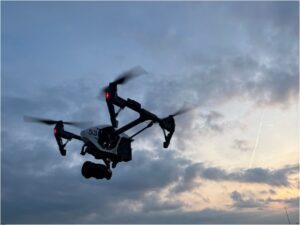
Pierce Aerospace, a Techstars-backed company, is a Remote ID service provider focused on practical and robust integration of Remote ID services into the drone ecosystem. Pierce Aerospace worked with the Department of Homeland Security and other federal, state, and local agencies to deploy Remote ID at the NFL’s Super Bowl LVII, in a successful test of Remote ID for operational support of a National Special Security Event. Pierce Aerospace deployed its Bluebird Remote ID Receivers and B1 Remote ID Beacons around State Farm Stadium to support airspace operations for NFL coordinated broadcast flights, a commercial drone swarm, and in support of law enforcement drone flights and operations.
“To our knowledge, this was the harshest stress test that Remote ID has seen to date,” said Aaron Pierce, CEO of Pierce Aerospace. “Nearly 73,000 fans were inside that stadium. All with cell phones and other WiFi and Bluetooth emitting devices, many of whom were streaming or uploading photos and video during the halftime show. We’re happy to share that our engineers successfully detected and tracked our Remote ID beacons with phones inside the stadium during this high-noise floor event.”
Pierce Aerospace provided its ASTM F3411-22 compliant B1 Remote ID beacons to pilots for FAA-approved commercial drone flights and law enforcement drone operations. Bluebird Remote ID Receivers were deployed around the stadium and used to successfully detect, track, and identify the equipped drones in the week leading up to the Super Bowl and on game day. Using COPERS, a web-based situational awareness tool developed by KBR, Inc., local broadcast messages collected by the Pierce Aerospace’s Receiver Network and Remote ID data feeds were routed to COPERS for airspace activity monitoring. COPERS, which stands for Command Oversight or Personnel, Equipment, Response and Situation, was made available to federal and local law enforcement end users across security command elements to monitor the Remote ID data feeds both on-site and remotely.
“We’ve been working with the Department of Defense since 2018 to take local broadcast Remote ID messages and network them to various tiers of end users in DOD experimental events. It was exciting to take the institutional knowledge that we’ve developed over the years and deploy it for the first time in support of real-world national security operations at the Super Bowl,” said Pierce. “This was an operational test of Remote ID before officially rolling it out as an FAA regulatory requirement in September. I’m happy to share that this deployment emphasized ‘operational.'”
“Pierce Aerospace’s Remote ID products and their integration capabilities helped ease the Command and Control of the Super Bowl LVII Temporary Flight Restriction [TFR] when it came to authorized vs unauthorized UAS operations,” said Greg Bean, Special Operations Security for the FAA. “We look forward to the full roll out of the FAA’s Remote ID rule in September 2023.”
Read more:
- Pierce Aerospace, DRONERESPONDERS Announce Public Safety Remote ID Working Group
- Pierce Aerospace, DroneShield Partner on Integration of Remote ID and Counter Drone Tech
- Indiana’s Remote ID Tech, India’s Drone Delivery: Pierce Aerospace Partners with Skye Air Mobility
- U.S. Government Agencies Invest in Counter UAS: DroneShield’s $33 Million Contract
Miriam McNabb is the Editor-in-Chief of DRONELIFE and CEO of JobForDrones, a professional drone services marketplace, and a fascinated observer of the emerging drone industry and the regulatory environment for drones. Miriam has penned over 3,000 articles focused on the commercial drone space and is an international speaker and recognized figure in the industry. Miriam has a degree from the University of Chicago and over 20 years of experience in high tech sales and marketing for new technologies.
For drone industry consulting or writing, Email Miriam.
TWITTER:@spaldingbarker
Subscribe to DroneLife here.